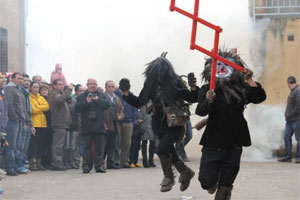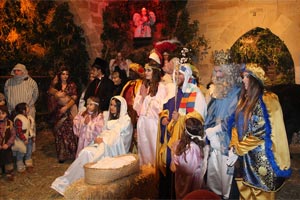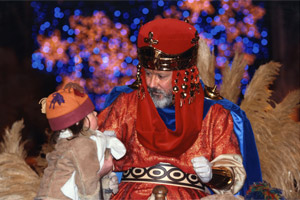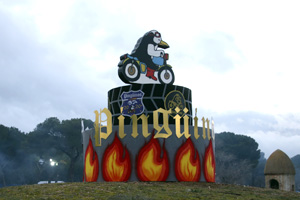Holly Week in Yecla
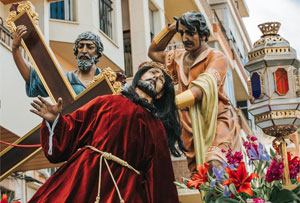
Origin
Easter Week in Yecla has a rich religious and cultural history that has been mentioned by Spanish novelists such as Azorín and Pío Baroja. This celebration dates back to the 17th century and consists of 19 brotherhoods and 11 processions. The main image is the Virgen de las Angustias by the sculptor Salzillo, declared an Asset of Cultural Interest, as is the Basílica de La Purísima, which is the departure and collection point for the processions.
In recent decades, Easter Week in Yecla has managed to combine its growth with the maintenance of tradition and religious sentiment. For this reason, work is currently underway to obtain the declaration of National Tourist Interest by the Spanish Government. At present, it is already recognised as being of Regional Tourist Interest.
Processions
The Holy Week processions begin on the Friday of Sorrows with the Procession of the 7 Words, where the 7 Parades of Christ are performed and recited by the "Pregonero" (Town Crier) on horseback. On Passion Saturday the Procession of the Blood and Forgiveness takes place, the most recent of all, as it was established in 2008.
Palm Sunday
Palm Sunday begins with the Procession of the Palms or "la Burrica". The procession is accompanied by a multitude of children and elderly people carrying palms and olive branches. On Easter Monday the Rosary Procession takes place, where the mysteries of the Rosary are prayed and meditated upon. At the beginning, at the end and at each mystery, "Motets of Polyphony" are sung.
Holy Tuesday
Holy Tuesday has the most different procession of Holy Week in Yecla, the Procession of the "Farolicos", reserved for children. Several hundred children accompany the Recumbent Christ carrying the typical "Farolicos" in a procession that is unique in the annals of Holy Week in Spain.
Maundy Thursday
Maundy Thursday begins with the Passion Procession in the afternoon, where passages from the Prayer in the Garden to the Virgen de la Esperanza are represented, without forgetting the Virgen de las Angustias, the jewel of Holy Week in Yecla. More than 3,000 brotherhoods make up this parade full of light, music, flowers, art and religiosity. At night, the Procession of Silence goes through the centre of the city, between the notes of the "Saetas del Silencio" and the recitation of the "Via Crucis".
Good Friday
On Good Friday, the early morning Procession of Calvary relives the sufferings of Christ before being crucified, paying special attention to the act of "La Cortesía". In the afternoon, the Procession of the Holy Burial, the oldest in Yecla (XVI-XVII), offers a dignified burial of Christ in the Church of San Francisco. At its conclusion, the Procession of Solitude starts from the Church of San Francisco to accompany Mary Magdalene, St. John and the Virgin Mary mourning after the loss of her son.
Easter Sunday
On Easter Sunday, the Resurrected Procession presents the typical and unique character of Yecla's Holy Week: "El Diablico". This character runs through the streets in a symbolic flight before the triumph of life over death and good over evil. It is an ideal activity to enjoy with children, who have fun throwing sweets at "El Diablico" in the "Suelta del Diablo" in the Plaza Mayor (don't worry, he is protected and will not be harmed). But remember that throwing other objects is prohibited.
How to watch the processions
The processions leave from the Basilica of the Purisima and the Plaza Mayor, where you can appreciate the characteristic acts of La Cortesia (Good Friday) and El Encuentro (Easter Sunday).
Moments you shouldn't miss
Among the most outstanding moments are the two most important steps from a historical point of view: the Virgen de las Angustias (BIC) by Francisco Salzillo (1763) and the Stmo. Cristo de la Adoración de la Cruz, also known as "El Cristico", by José Esteve Bonet (1800).
The Burial of Christ, on Good Friday, is one of the most emotional moments. With the sunset, the Holy Burial of Christ begins, composed of seventeen steps. One of the most significant moments is the act presided over by the authorities. At midnight, the Virgin of Solitude is accompanied to her abode in the Procession of Solitude, during which the people intone the endearing notes of the "Stabat Mater Dolorosa". "The Farewell Talk" or "Sermon of Solitude" ends this long day.
Other activities you cannot miss are listening to a saeta song, following the transfer of a step, and enjoying the Sunday of Resurrection with the "Encounter between Jesus and his mother", as well as the popular "Suelta del Diablo".
What to see in Yecla
Yecla is a city that offers a great variety of tourist attractions. In the historic center, you can visit the Basilica of the Purisima, which houses the image of the patron saint of the city and is a place of pilgrimage for many faithful. You can also stroll through the Plaza Mayor, where some of the most outstanding events of Holy Week are held, such as La Cortesia and El Encuentro.
As for monuments, the Tower of Homage of the castle stands out, offering panoramic views of the city, and the Palace of the Council, which is currently the headquarters of the City Council and has a beautiful Baroque facade.
Culture lovers can enjoy visits to museums such as the Municipal Archaeological Museum, the Holy Week Museum, the Wine Museum, located in a 19th-century winery, and the Ethnic Music Museum of Yecla.
In addition, Yecla is famous for its furniture production and has a large number of shops and factories that offer high-quality and design pieces. It is also a wine tourism destination, as the city is located in the Yecla Designation of Origin and has numerous wineries and cooperatives that offer tastings and guided tours.
Finally, the city has numerous parks and natural spaces where you can enjoy nature, such as the Sierra del Carche Regional Park or the Constitution Park.
What to eat in Yecla
Yecla is famous for its gastronomy, especially its wine, but there is also a great variety of local dishes that you can't miss:
- Gazpacho Yeclano: A variant of the Andalusian gazpacho, with a thicker and spicier consistency.
- Rice with rabbit and snails: A dish of rice with rabbit and snails, slowly cooked with garlic, tomato, and paprika.
- Cured meats: Excellent cured meats such as longaniza, chorizo, and salchichón are produced in Yecla.
- Lamb Caldero: A lamb stew with potatoes and rice, cooked in an iron pot.
- Michirones: A typical dish from the Region of Murcia and Yecla, which consists of a soup of dried beans with chorizo, pancetta, and paprika.
- Cheeses: Yecla produces a wide variety of artisanal cheeses, such as goat cheese, sheep cheese, and aged cheese.
- Wine: The Yecla Designation of Origin produces some of the best wines in the Region of Murcia, with Monastrell and Syrah grape varieties.
Don't leave without trying these delicious local specialties!


